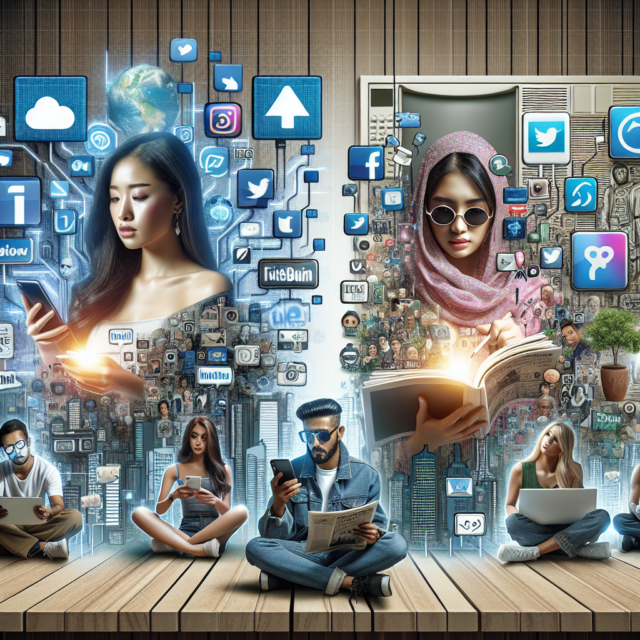In recent years, the landscape of marketing and media consumption has undergone a seismic shift, largely driven by the rise of digital influencers and models. These new-age personalities wield a significant amount of power in shaping consumer preferences and trends, thanks to the proliferation of social media platforms and digital content. This article delves into the intricacies of the digital influencer phenomenon, examines the evolution of online models, and explores the profound impact these digital entities have on consumer behavior.
Understanding the Digital Influencer Phenomenon
In the digital age, influencers have emerged as a formidable force, redefining the way brands communicate with their audiences. Unlike traditional celebrities, digital influencers often earn their status through authenticity and relatability, engaging with followers on a more personal level. This unique connection has positioned influencers as trusted voices in the digital sphere, capable of swaying public opinion and consumer choices with a single post or story.
The exponential growth of social media platforms like Instagram, YouTube, and TikTok has been instrumental in the rise of digital influencers. These platforms provide the perfect stage for individuals to showcase their talents, share their lives, and build communities. As a result, influencers have become a diverse group, ranging from beauty gurus and fitness enthusiasts to tech reviewers and travel bloggers, each catering to niche audiences with specific interests.
Brands have quickly recognized the potential of influencer marketing as a cost-effective and impactful strategy. By collaborating with influencers, companies can tap into their large and engaged follower base, gaining access to new customer segments. This shift in marketing strategy has also democratized the industry, allowing smaller brands to compete with larger counterparts by leveraging influencer partnerships.
The authenticity of digital influencers is their greatest asset. Unlike polished advertising campaigns, influencer content often feels more genuine and relatable, resonating with audiences in a way that traditional media struggles to achieve. This authenticity fosters trust, making followers more likely to act on recommendations from influencers they admire.
However, the rise of digital influencers has not been without challenges. Issues such as transparency, authenticity, and the blurring of personal and promotional content have sparked debates about the ethical responsibilities of influencers. As the industry matures, there is an increasing demand for clear guidelines and regulations to ensure transparency and accountability.
Overall, the digital influencer phenomenon represents a paradigm shift in media consumption and brand communication. As influencers continue to evolve and adapt to changing technologies and consumer preferences, their role in shaping the digital landscape remains indispensable.
The Evolution of Online Models in Modern Media
The concept of modeling has been transformed by the digital age, with online models gaining prominence and reshaping the industry. The evolution of online models can be attributed to the accessibility of digital platforms, which have democratized the modeling world, offering opportunities to individuals beyond the traditional confines of fashion capitals.
Social media has been a game-changer for aspiring models, allowing them to showcase their portfolios to a global audience without the need for traditional agency representation. Platforms like Instagram have become virtual runways, where models can share their work, gain followers, and attract the attention of brands and designers. This shift has enabled a more inclusive and diverse representation of beauty, challenging conventional standards.
The rise of online models has also given birth to the phenomenon of virtual models—computer-generated personas that exist solely in the digital realm. These virtual models, such as Lil Miquela and Shudu, have amassed significant followings and have been featured in high-profile campaigns. Their existence blurs the lines between reality and fiction, raising intriguing questions about the future of modeling and the role of technology in fashion.
Online models have embraced the role of content creators, producing engaging and visually appealing content that resonates with their audience. By leveraging their unique perspectives and personal experiences, they forge genuine connections with followers, fostering a sense of community and belonging. This shift has empowered models to take control of their careers, curate their personal brands, and collaborate with brands on their terms.
The evolution of online models has also sparked discussions about the impact of digital technology on body image and self-esteem. While social media has provided a platform for diverse representations, it has also perpetuated unrealistic beauty standards and the pressure to maintain a curated online persona. The industry is now grappling with finding a balance between celebrating diversity and promoting authenticity.
In conclusion, the evolution of online models highlights the transformative power of digital technology in reshaping the modeling industry. As the boundaries between virtual and reality continue to blur, the future of modeling promises to be dynamic and ever-evolving, driven by technological advancements and changing consumer expectations.
Impact of Digital Influencers on Consumer Behavior
Digital influencers have a profound impact on consumer behavior, altering the way people discover, evaluate, and purchase products. Their ability to connect with audiences on a personal level makes them powerful agents of persuasion, often driving consumer decisions through their recommendations and endorsements.
One of the key ways influencers impact consumer behavior is through the concept of social proof. Followers often perceive influencers as trusted authorities in their respective niches, and their approval of a product or service serves as a form of validation. This social proof can significantly influence purchasing decisions, as consumers are more likely to trust recommendations from someone they admire.
Influencers also play a crucial role in shaping trends and introducing new products to the market. By showcasing products in their content, influencers can create buzz and generate interest, often leading to increased demand and sales. This trendsetting ability has made influencers valuable partners for brands looking to launch new products or enter new markets.
The interactive nature of social media platforms allows influencers to engage with their audience in real-time, fostering two-way communication and building a sense of community. This engagement enhances the influencer’s credibility and strengthens the bond between them and their followers. As a result, consumers feel more connected to the influencer’s recommendations, increasing the likelihood of conversion.
However, the impact of digital influencers on consumer behavior is not without challenges. The rise of influencer marketing has led to concerns about authenticity and transparency, with some critics arguing that sponsored content blurs the line between genuine recommendations and paid endorsements. This has prompted calls for greater transparency and disclosure in influencer marketing practices.
Moreover, the influencer-driven consumer culture has raised questions about materialism and the pressure to conform to trends. The constant exposure to curated lifestyles and luxury products can create unrealistic expectations and contribute to a culture of comparison and consumption. As the industry evolves, there is a growing awareness of the need for responsible and ethical influencer practices.
In summary, digital influencers wield significant influence over consumer behavior, shaping trends, and driving purchasing decisions. As the industry continues to grow and adapt, the role of influencers in the consumer journey will remain a critical area of exploration and innovation.
The rise of digital influencers and models marks a pivotal moment in the history of media and marketing. As they continue to redefine the rules of engagement and influence, their impact on consumer behavior, brand strategies, and the modeling industry is undeniable. While challenges remain, the potential for innovation and growth in this digital landscape is vast, promising exciting opportunities for brands, influencers, and consumers alike. As we navigate this evolving terrain, it is crucial to embrace the changes, address the challenges, and harness the power of digital influencers and models to shape a more inclusive and authentic digital future.


















